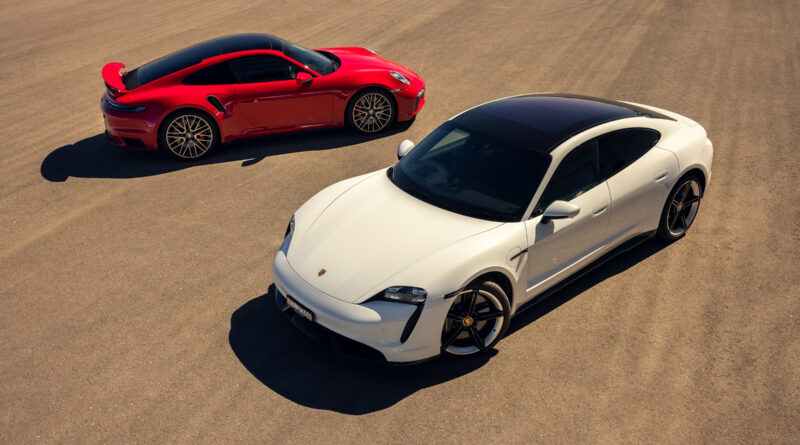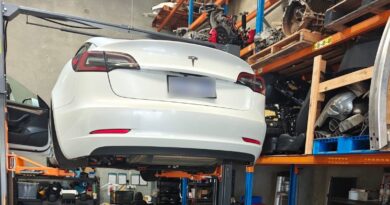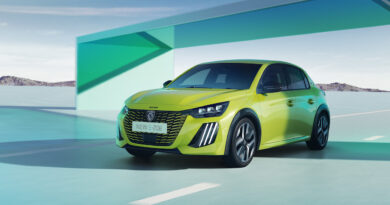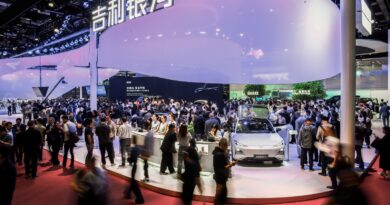Porsche Taycan v Porsche 911: EV v ICE sports car track test
Choosing a fast Porsche gets harder by the year, and it’s now even harder, given the German sports car specialist has unleashed its first EV, the Taycan.
The pure electric car promises big straight-line performance, serious cornering ability and the all-rounded nous to stand up to some race track hot laps.
All of which sounds very familiar to anyone who’s been in the market for the pinnacle of Porsche performance, the 911.
But which is best? Which is quickest? And which should you choose for a daily performance fix?
Want the latest EV news and reviews delivered to your inbox? Subscribe to our weekly newsletter!
Porsche v Porsche: Electric v petrol
Those questions brought us to the newest – and one of the best – race tracks in the country, The Bend.
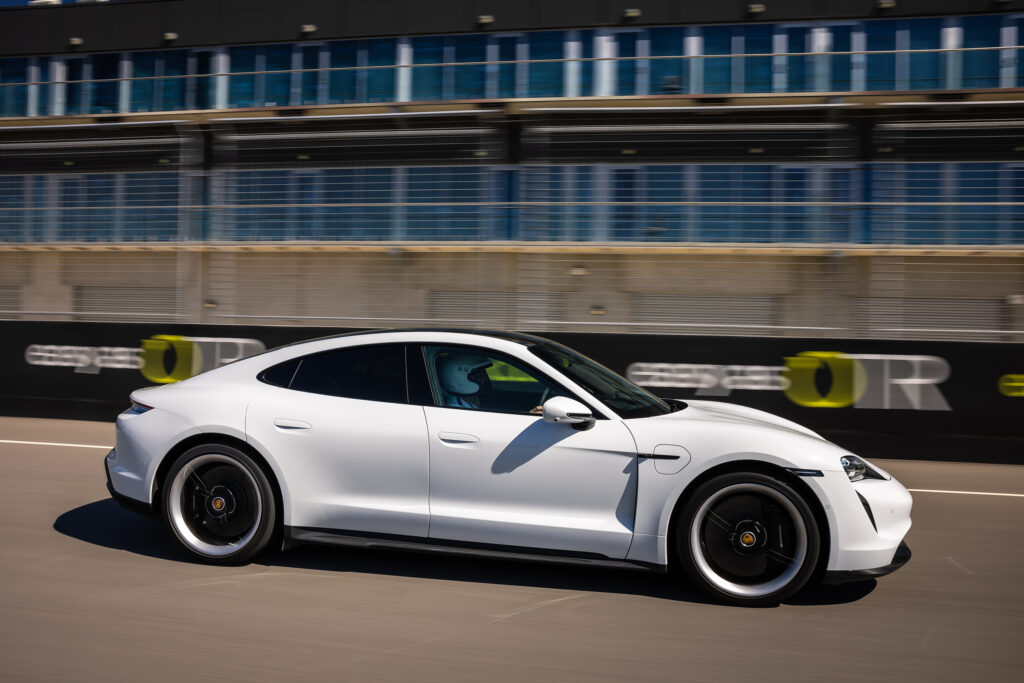
About an hour and a half east of Adelaide, the $100 million-plus facility is among the most impressive in the country and houses the second-longest permanent race track in the world (at 7.77km in its longest configuration, only the Nurburgring in Germany is longer).
As well as the fastest in the Porsche electric fleet, the Taycan Turbo S (no, there are no turbos, the badge is purely marketing…) we’ve also got access to a 911 Turbo.

Porsche v Porsche: both turbos, at least by badge, but only one with a turbo (or two, to be precise).
Anyone familiar with their 911s will know there are about 20 variants to choose from and the moving-feast menu is updated every few months with new arrivals and updates.

The 911 Turbo has just joined the range, slotting beneath the even faster 911 Turbo S. Both are at the pinnacle of the 911 lineup, and while they don’t have the race track focus of a 911 GT3 (or the potent now-discontinued GT2) the Turbo and Turbo S are designed for ballistic pace teamed with everyday liveability.
Just like a Taycan.
The numbers
The Taycan Turbo S gets two electric motors (one at each end) making a combined 460kW, but that jumps to 560kW for up to 2.5 seconds when utilising the launch control system that makes for ballistic take-offs.
It’s backed up by 1050Nm, something that gives it a clear advantage over the 911 Turbo.
But… there’s always a but… the Taycan is a heavy beast thanks to its 83.7kWh battery pack. The total weight is a hefty 2295kg. The 911 Turbo, on the other hand, tips the scales at 1640kg, a full 655kg lighter.
| Porsche Taycan Turbo S EV | Porsche 911 Turbo | |
| Price: | $338,500 | $396,500 |
| Engine/motors: | Dual-motor, AWD | 3.8-litre twin-turbo six-cylinder |
| Power: | 460kW (560kW with overboost) | 427kW |
| Torque: | 1050Nm (with overboost) | 750Nm |
| Transmission: | 2-speed automatic | 8-speed twin-clutch automatic |
| Weight: | 2295kg | 1640kg |
| Tyres (front): | 21-inch, 265/35 | 20-inch, 255/35 |
| Tyres (rear): | 21-inch, 305/30 | 21-inch, 315/30 |
But it’s also got less to play with in term of raw output. Its 3.8-litre twin-turbo horizontally-opposed six-cylinder makes 427kW and 750Nm. Big numbers on their own, but comfortably outdone by the electric Taycan.
As for pricing, the Taycan Turbo S is the most expensive in the EV family, at $338,500 plus on-road costs (at this level they can vary between state/territory). But the 911 Turbo is even more, at $396,500.
The Porsche drag race: 911 v Taycan
Our first test was simple. Line the cars up on the near-one-kilometre-long straight, activate the launch control systems (which is the best way to get a Porsche off the line) and keep the accelerator pedal pushed to the floor.
Both cars drive all four wheels and both promise a 2.8-second dash to 100km/h.
Earlier in the day – when it was significantly cooler and we were using different timing equipment – the Taycan Turbo S clocked a 2.49-second dash to 100km/h. That’s seriously quick, and the way it pulls so strongly instantly requires a recalibration of your brain. It’s potent stuff.
When we tried again using our VBox the Taycan’s time was slightly slower, at 2.91 seconds to 100km/h. The 911 Turbo also missed its claim slightly (most of the time you can comfortably beat the Porsche claim) with a 2.87-second 0-100km/h dash. With circa-30-degree heat that may not have helped.
We used those slower figures because they are directly comparable: same machinery, same temperature, same piece of race track.
And they’re seriously close, which had me delving deeper into the figures.
The 911 Turbo was fractionally slower launching, but we’re talking fractionally: just 0.03 seconds to 10km/h.
The difference was bigger when analysing the maximum G forces produced under acceleration: the Taycan managed a staggering 0.78G while the 911 Turbo pulled a still-impressive 0.56G.
The Taycan outdid the 911 Turbo to 60km/h but the tables were turned by the time each topped 100km/h, the Taycan four-hundredths-of-a-second behind the 911.
While the 911 Turbo shuffles through its eight-speed transmission, the Taycan Turbo S makes a single gear change at around 90km/h, the constant e-motor surge never letting up, although trailing the 911’s pull into triple figures.
But it’s the 911’s comparative athleticism that gives it a more meaningful – albeit still slight – edge for the 100-200km/h dash. Where the Taycan took 7.00 seconds, the 911 narrowed that to 6.80 seconds.
The 0-200km/h totals were 9.91 seconds for the Taycan, 9.67 seconds for the 911.
Interestingly, for the benchmark 0-400m sprint there was just 0.06 seconds between the two, the 911 victorious at 10.74 seconds versus 10.80 for the Taycan.
Whereas the Taycan crossed the 400m finish line travelling 207km/h, the 911 was building pace slightly faster and managed 210km/h.
| Porsche Taycan Turbo S EV | Porsche 911 Turbo | |
| 0-10km/h | 0.25 seconds | 0.28 seconds |
| 0-20km/h | 0.51 seconds | 0.51 seconds |
| 0-30km/h | 0.75 seconds | 0.75 seconds |
| 0-40km/h | 0.99 seconds | 0.99 seconds |
| 0-50km/h | 1.23 seconds | 1.23 seconds |
| 0-60km/h | 1.50 seconds | 1.55 seconds |
| 0-70km/h | 1.81 seconds | 1.81 seconds |
| 0-80km/h | 2.16 seconds | 2.14 seconds |
| 0-90km/h | 2.50 seconds | 2.49 seconds |
| 0-100km/h | 2.91 seconds | 2.87 seconds |
| 0-110km/h | 3.36 seconds | 3.32 seconds |
| 0-120km/h | 3.86 seconds | 3.82 seconds |
| 0-130km/h | 4.40 seconds | 4.35 seconds |
| 0-140km/h | 5.00 seconds | 4.91 seconds |
| 0-150km/h | 5.66 seconds | 5.52 seconds |
| 0-160km/h | 6.38 seconds | 6.24 seconds |
| 0-170km/h | 7.16 seconds | 7.01 seconds |
| 0-180km/h | 8.02 seconds | 7.86 seconds |
| 0-190km/h | 8.96 seconds | 8.82 seconds |
| 0-200km/h | 9.91 seconds | 9.67 seconds |
| 0-400m | 10.80 at 207km/h | 10.74 at 210km/h |
| Hot laps around The Bend West Circuit | ||
| Lap time | 1:30.39 | 1:26.98 |
| Average speed | 134km/h | 139km/h |
Hot laps: 3.41km West Circuit
The Bend’s headline track is 7.77km long and includes an impressive array of challenges.
But our test track is the shorter 3.41km West Circuit that includes the main straight and 12 corners dishing up everything from tight hairpins to fast sweepers.
It’s a challenging layout but one that nicely tests brakes, grip, handling and acceleration.
Cutting to the chase… the 911 Turbo was comfortably quicker around a hot lap, its 1:26.98 time a healthy 3.41 seconds quicker than the Taycan Turbo S.
The track map below gives detailed data on G forces and speeds at various parts. There’s also a summary of the key performance metrics at the bottom of this article.

Electric v petrol: Corner by corner
Much of the difference comes down to cornering poise and grip.
The 911 Turbo is lighter and more consistent under brakes. You can lean on them harder and leave the braking a tad later.
Every time we needed it to stop hard it pulled up slightly harder than the Taycan Turbo S.
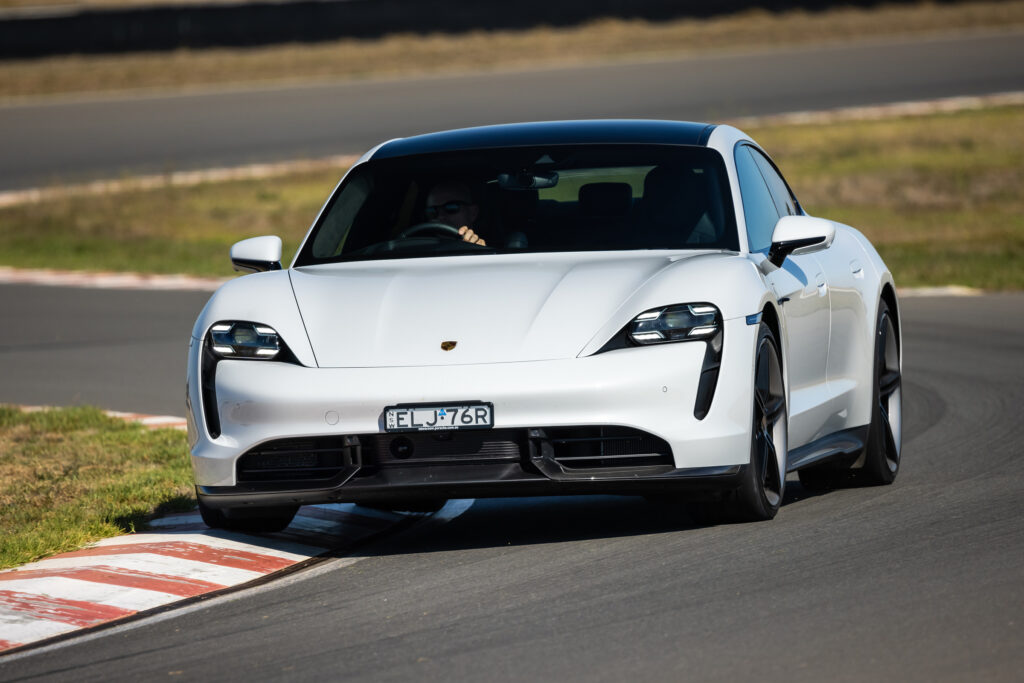
There’s better consistency in the 911 Turbo brakes, too, almost encouraging you to dive deeper.
Not that there was heaps in it. The Taycan’s peak G reading under brakes was 1.29g, compared with 1.42 for the 911 Turbo. They’re astonishing numbers, and in isolation the Taycan’s braking brutality is phenomenal; better still that those brakes keep copping 2.3 tonnes of 200km/h-plus punishment with no hint of fade. It helps they’re track-honed carbon ceramic brakes.
But, again, it was braking zone after braking zone that the 911 had an advantage.
Neither showed any sign of fade, suggesting there will be little issue with repeated hot laps.
Keep in mind the 911 is a high bar. Porsche 911s have among the best brakes of any car on the road, so that the Taycan performs as well as it does is seriously impressive.
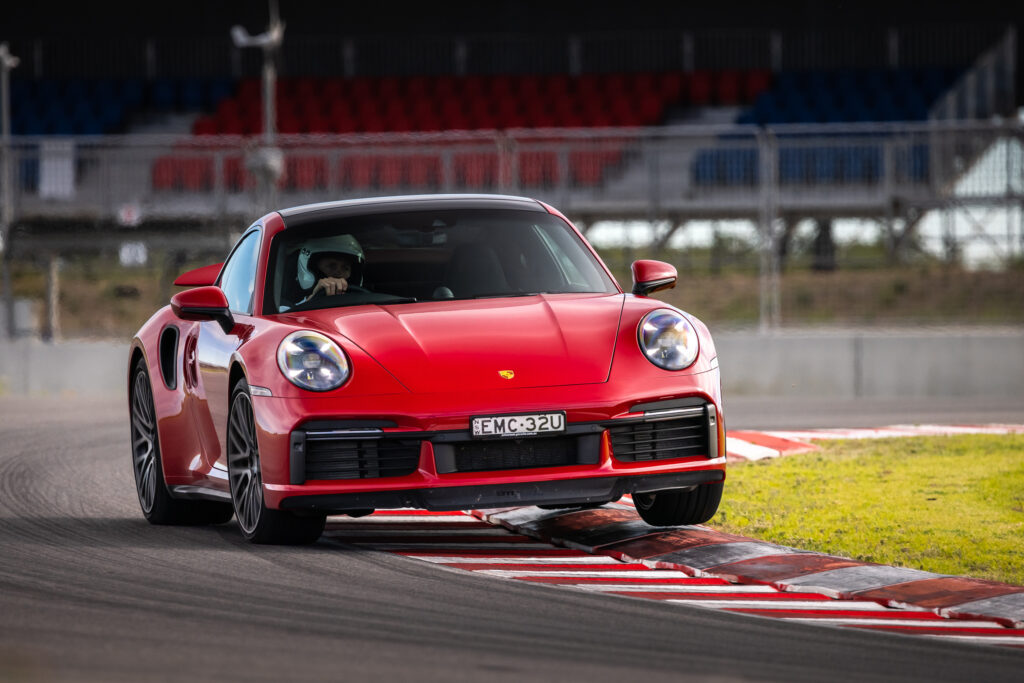
Interestingly the Taycan’s electric pace and better weight distribution (the 911 has more weight over its rear wheels than its fronts) seemed to be more conducive to carrying a little more speed at the slowest point of slower corners.
In faster corners the 911 had the advantage.
But sometimes you had to work at it. I found myself carrying an extra few kays where I was occasionally busy getting the 911 to point through the corner before reapplying power. With a light nose it’s critical the 911 is facing the right direction before you stomp on the throttle, at which point it’ll understeer if you’re still turning too much.
Aerodynamics, grip and more
But the 911 consistently managed higher G forces in the corners. Thank grip for that one. The 911 also has more aggressive active aerodynamics for downforce, the front lip spoiler that protrudes closer to the ground and the extended rear wing all playing their part in pinning the car to the bitumen.
The aero contest swings the other way with the Taycan when it comes to wind resistance. The Taycan Turbo S has an impressively low 0.25 drag coefficient (Cd), whereas the 911 Turbo is 0.33 (the additional cooling vents and intakes required to cool the engine is the main differentiator). Plus, the Taycan gets an active rear wing to boost downforce at higher speeds.
Cornering is very different between the two as well.

Where the 911 settles and hunkers down, the Taycan seriously tests its 21-inch rubber with that 2.3-tonne kerb weight.
While it’s impressively adjustable in a corner and surprisingly forgiving, the Taycan ultimately can’t hang on as tenaciously as the 911.
Similarly, what occasionally hurts the 911 – more weight over the rear – helps it when it comes time to getting the power down.
Massive 315mm-wide rear tyres (10mm wider than the Taycan’s rears) do a brilliant job of harnessing all that grunt and sling-shotting it out of a corner.
Sure, the Taycan also has impressive tyre dimensions – its 265mm-wide front tyres are 10mm wider than the 911’s – but it doesn’t leap quite as hard out of the corner.

High speeds are also the 911’s friend, its top speed claimed at 320km/h versus the Taycan’s 260km/h.
Any time we checked the data down the straight the 911 consistently had a near-10km/h advantage, something that adds up over a lap.
That said, there were times mid-corner where the Taycan’s effortless acceleration gave it a momentary speed advantage, although once the exit of the corner opened up the 911 quickly surpassed it.
Electric Porsche is seriously quick against performance heroes
Sure, the Taycan Turbo S was outblasted by its 911 Turbo sibling, at least in our track thrash.
But it’s worth putting its achievements into context.
From what we can tell the 1:30.39 lap time is one of the fastest of any production car around the West Circuit.
That West Circuit is the same one used by Motor Magazine for its Performance Car of the Year testing in 2019 and 2020.
In 2019 the only cars at PCOTY faster than the Taycan Turbo S were the Porsche 911 GT2 RS (the fastest 911 ever created), Mercedes-AMG GT C and rear-drive Audi R8. Our Taycan lap time was quicker than the BMW M5 Competition, Audi RS4 Avant and many other highly fancied performance machinery.
In 2020 there was only one car faster than the Taycan Turbo S at PCOTY – the Mercedes-AMG GT63 S. The electric Porsche was quicker than the regular Porsche 911 Carrera S, the Toyota Supra GTS, Lotus Exige Sport 410, Lexus RC F and Chevrolet Camaro ZL1.
Sure, they were different drivers on different days, but our driving was done by yours truly whereas PCOTY uses a professional who would almost certainly further lower the Taycan lap times.
And yes, temperature, sunlight, wind and how much dust is on the track can all change lap times in the same car from one day to the next.
But it’s unlikely to change things markedly, which reinforces just how quick the Taycan Turbo S is.
Recharge v refuel
As an added bonus, the 911 Turbo needed refueling before the Taycan Turbo S needed a charge.
Yes, both are using loads of energy in the quest for speed, but the Taycan can at least re-harness some of that energy through regenerative braking, putting up to 265kW back into the battery pack on big decelerations.
The Taycan needed a quick charge through the day, but it copped a serious thrashing and absolutely held its own against arguably the best in the business: a Porsche 911.
Porsche has now added Taycans to its Track Experience days that allow owners to drive the cars briskly in a controlled environment.
Electric v petrol: And the winner is…
If you’re looking for the fastest car around a race track the 911 Turbo comfortably beats the Taycan Turbo S. More grip and less weight makes it a more potent machine – and one better suited to track thrashes – even if it does have less power.
The Taycan Turbo S returns serve with more brutal initial off-the-line acceleration.
Plus, the Taycan stands up phenomenally well and will comfortably beat many highly-fancied performance machines on a hot lap.
And in a straight line there’s nothing in it between 911 Turbo and Taycan Turbo S. The two accelerate almost identically, with the Taycan gaining a slight initial advantage but losing it over 100km/h.
That it does it purely on electricity and with the best driving dynamics of any EV currently available adds to its appeal.
So, for road driving the Taycan Turbo S is arguably a better everyday bet – plus it even comes with back doors!
Taycan Turbo S v 911 Turbo: The numbers
| Porsche Taycan Turbo S EV | Porsche 911 Turbo | |
| Price: | $338,500 | $396,500 |
| 0-60km/h: | 1.50 seconds | 1.55 seconds |
| 0-100km/h: | 2.91 seconds | 2.87 seconds |
| 0-200km/h: | 9.91 seconds | 9.67 seconds |
| 0-400m: | 10.80 at 207km/h | 10.74 at 210km/h |
| Max cornering G: | 1.27 | 1.32 |
| Max braking G: | 1.29 | 1.42 |
| Max accelerating G: | 0.78 | 0.56 |
| Top speed at The Bend: | 249km/h | 258km/h |
| West Circuit lap time: | 1:30.39 | 1:26.98 |
| Average lap speed: | 134km/h | 139km/h |

